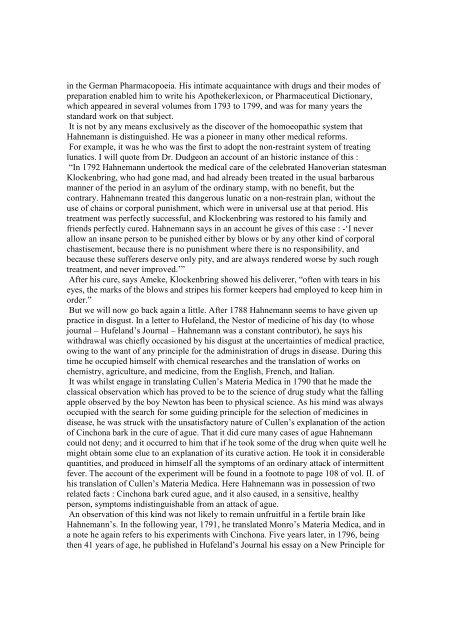CLARKE JH, Homoeopathy Explained - Classical Homeopathy Online
CLARKE JH, Homoeopathy Explained - Classical Homeopathy Online
CLARKE JH, Homoeopathy Explained - Classical Homeopathy Online
Create successful ePaper yourself
Turn your PDF publications into a flip-book with our unique Google optimized e-Paper software.
in the German Pharmacopoeia. His intimate acquaintance with drugs and their modes of<br />
preparation enabled him to write his Apothekerlexicon, or Pharmaceutical Dictionary,<br />
which appeared in several volumes from 1793 to 1799, and was for many years the<br />
standard work on that subject.<br />
It is not by any means exclusively as the discover of the homoeopathic system that<br />
Hahnemann is distinguished. He was a pioneer in many other medical reforms.<br />
For example, it was he who was the first to adopt the non-restraint system of treating<br />
lunatics. I will quote from Dr. Dudgeon an account of an historic instance of this :<br />
“In 1792 Hahnemann undertook the medical care of the celebrated Hanoverian statesman<br />
Klockenbring, who had gone mad, and had already been treated in the usual barbarous<br />
manner of the period in an asylum of the ordinary stamp, with no benefit, but the<br />
contrary. Hahnemann treated this dangerous lunatic on a non-restrain plan, without the<br />
use of chains or corporal punishment, which were in universal use at that period. His<br />
treatment was perfectly successful, and Klockenbring was restored to his family and<br />
friends perfectly cured. Hahnemann says in an account he gives of this case : -‘I never<br />
allow an insane person to be punished either by blows or by any other kind of corporal<br />
chastisement, because there is no punishment where there is no responsibility, and<br />
because these sufferers deserve only pity, and are always rendered worse by such rough<br />
treatment, and never improved.’”<br />
After his cure, says Ameke, Klockenbring showed his deliverer, “often with tears in his<br />
eyes, the marks of the blows and stripes his former keepers had employed to keep him in<br />
order.”<br />
But we will now go back again a little. After 1788 Hahnemann seems to have given up<br />
practice in disgust. In a letter to Hufeland, the Nestor of medicine of his day (to whose<br />
journal – Hufeland’s Journal – Hahnemann was a constant contributor), he says his<br />
withdrawal was chiefly occasioned by his disgust at the uncertainties of medical practice,<br />
owing to the want of any principle for the administration of drugs in disease. During this<br />
time he occupied himself with chemical researches and the translation of works on<br />
chemistry, agriculture, and medicine, from the English, French, and Italian.<br />
It was whilst engage in translating Cullen’s Materia Medica in 1790 that he made the<br />
classical observation which has proved to be to the science of drug study what the falling<br />
apple observed by the boy Newton has been to physical science. As his mind was always<br />
occupied with the search for some guiding principle for the selection of medicines in<br />
disease, he was struck with the unsatisfactory nature of Cullen’s explanation of the action<br />
of Cinchona bark in the cure of ague. That it did cure many cases of ague Hahnemann<br />
could not deny; and it occurred to him that if he took some of the drug when quite well he<br />
might obtain some clue to an explanation of its curative action. He took it in considerable<br />
quantities, and produced in himself all the symptoms of an ordinary attack of intermittent<br />
fever. The account of the experiment will be found in a footnote to page 108 of vol. II. of<br />
his translation of Cullen’s Materia Medica. Here Hahnemann was in possession of two<br />
related facts : Cinchona bark cured ague, and it also caused, in a sensitive, healthy<br />
person, symptoms indistinguishable from an attack of ague.<br />
An observation of this kind was not likely to remain unfruitful in a fertile brain like<br />
Hahnemann’s. In the following year, 1791, he translated Monro’s Materia Medica, and in<br />
a note he again refers to his experiments with Cinchona. Five years later, in 1796, being<br />
then 41 years of age, he published in Hufeland’s Journal his essay on a New Principle for
















